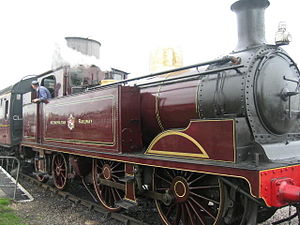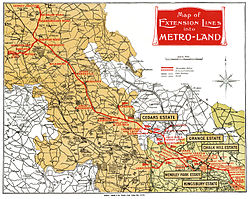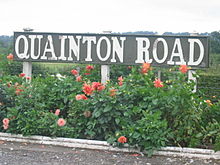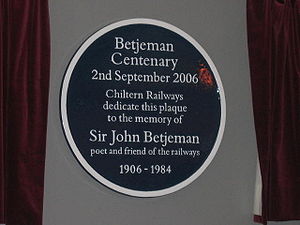- Metro-land
-
For other uses, see Metroland (disambiguation).
Metro-land (or Metroland) is a name given to the suburban areas that were built to the north west of London in the counties of Buckinghamshire, Hertfordshire and Middlesex in the early part of the 20th century, and were served by the Metropolitan Railway, an independent company until absorbed by the London Passenger Transport Board (LPTB) in 1933.
Contents
Origin
The Metropolitan Railway began as the world's first underground line in 1863. The word, métro, used in Paris as an abbreviation for its own Chemin de Fer Métropolitain, which opened in 1900, has since been adopted around the world. Metro-land was coined as a brand name by James Garland, of the Metropolitan's publicity department, to promote what the company first called its "extension" line, and later its "main" line. The term was used in advertisements and promotional publications from 1915 to 1934, although the railway itself was popularly known as "the Met" (rarely the "Metro").
The extension line
The extension line ran initially from Baker Street to Swiss Cottage (1868), reaching Harrow in 1880, Rickmansworth in 1887, Chesham in 1889 and, stretching ever deeper into the Chiltern Hills, Aylesbury in 1892. At Aylesbury it connected to the former Aylesbury and Buckingham Railway over whose tracks express trains ran from Baker Street to Verney Junction beginning in 1897. From 1899 the Metropolitan operated the line from Quainton Road (between Aylesbury and Verney Junction) to Brill, Buckinghamshire. There were further extensions to Uxbridge (1904), Watford (1925) and Stanmore (1932).
By the time the Metropolitan was taken over by the LPTB, over half of the line between Baker Street and Verney Junction was outside the geographical area covered by the Board.[1] Ward Lock's Guide to London informed visitors to the British Empire Exhibition, held at Wembley in 1924-5, that "Baker Street is the terminus of what must perforce be called the "country" lines of the Metropolitan Railway".[2]
The Metro-land guide
An annual guide, also called Metro-land, was published by the company from 1915 to 1932.[3] This replaced the Guide to the Extension Line, which first appeared in 1904. Metro-land encouraged leisure travel and also published facts and figures for the commuter and would-be resident. The 1924 edition featured the British Empire Exhibition, at which the Metropolitan had its own stand in the Palace of Engineering. The exhibition and the new Empire Stadium, which was first used for the Football Association Cup final in 1923, were served by the refurbished Wembley Park station.
Defining Metro-land
The Metro-land guide insisted that Metro-land was "a country with elastic borders that each visitor can draw for himself". Indeed, to the extent that the principal features of Metro-land were not unique to the Metropolitan, it has been invoked more generically: for example, by Kathryn Bradley-Hole writing about Gunnersbury Park,[4] and by the London Evening Standard, which, in 2009, under the heading, "Down the line into Metroland", identified High Barnet (Northern Line), Loughton (Central Line) and two Metropolitan suburbs, Amersham and Rickmansworth, as "top locations with an easy commute".[5] Even so, Metro-land was quite firm that, so far as the Buckinghamshire Chilterns were concerned, its "Grand Duchy" was confined to the hundred of Burnham: "the Chilterns round Marlow and the Wycombes are not in Metro-land".
The architect Hugh Casson regarded Harrow as the "capital city" of Metro-land,[6] while Arthur Mee's King's England described Wembley as its "epitome".[7]
Slogans and references
The Metropolitan’s terminus at Baker Street was "the gateway to Metro-land" and Chiltern Court, which opened over the station in 1929 and was headquarters during the Second World War of the Special Operations Executive, was "at the gateway to Metro-land". In similar vein, Chorley Wood & Chenies, later described by John Betjeman as "the essential Metro-land",[8] were "at the gateway" of the Chiltern Hills (of which Wendover was the "pearl").[9]
Literature and songs
Before the end of the First World War George R. Sims had incorporated the term in verse: "I know a land where the wild flowers grow/Near, near at hand if by train you go,/Metroland, Metroland". By the 1920s, the word was so ingrained in the consciousness that, in Evelyn Waugh’s novel, Decline and Fall (1928), the Hon Margot Beste-Chetwynd took Viscount Metroland as her second husband. Lady Metroland re-appeared in Vile Bodies in 1930. Metro-land further entered the public psyche with the song My Little Metro-land Home (lyrics by Boyle Lawrence and music by Henry Thraile, 1920), while another ditty extolled the virtues of the Poplars estate at Ruislip with the assertion that "It's a very short distance by rail on the Met/And at the gate you'll find waiting, sweet Violet".[10] Queensbury and its local surroundings and characters were cited in the song "Queensbury Station" by the Berlin-based punk-jazz band The Magoo Brothers on their album "Beyond Believable", released on the Bouncing Corporation label in 1988. The song was written by Paul Bonin and Melanie Hickford, who both grew up and lived in the area.[11] In 1997, Metroland was the title and setting for a movie starring Christian Bale about the development of the relationship between a husband and wife living in the area. The movie was based on the novel of the same name written by Julian Barnes.
"Live in Metro-land"
In 1903 the Metropolitan developed a housing estate at Cecil Park, Pinner, the first of many such enterprises over the next thirty years. Overseen by the Metropolitan's general manager from 1908–30, Robert H Selbie, the railway formed its own Country Estates Company in 1919. The slogan, "Live in Metro-land", was even etched on the door handles of Metropolitan carriages.
Some stations, such as Hillingdon (1923), were built specifically to serve the company's suburban developments. A number, including Wembley Park, Croxley Green (1925) and Stanmore (1932), were designed by Charles W. Clark (who was responsible also for Chiltern Court) in an Arts and crafts "villa" style. These were intended to blend with their surroundings, though, in retrospect, they arguably lacked the panache and vision of Charles Holden's striking, modern designs for the Underground group in the late 1920s and early 30s.
The demise of the Metropolitan company
By the time the Metropolitan disappeared as a separate company, the economic climate had begun to apply some brakes to the pace of residential development that had already submerged large areas of countryside. For a time, the LPTB used the "Metro-land" tag: "Cheap fares to Metro-land and the sea" were advertised in 1934. But the era of Metro-land as such was over and, indeed, the outer backwaters of the "Grand Duchy" beyond Aylesbury, such as the Brill branch and the line to Verney Junction – their sleepy features described in A G Macdonell’s England, Their England (1933) – were closed to Metropolitan trains by 1936. In that year London Transport introduced new, rather deadpan slogans which tended to emphasise excursions, rather than residential opportunities: "Away by Metropolitan" and "Good spot, the Chilterns".
Steam traction continued to be used on the outer sections of what had become the "Metropolitan Line" until 1961. From that date Metropolitan trains ran only as far as Amersham, with main line services from Marylebone covering stations between Great Missenden and Aylesbury.
Imitators
Nearly 70 years later the Chilterns Conservation Board was advertising "Chilterns Country – countryside walks from rail stations" (2004). Drawing no doubt on Metro-land, a guide for ramblers, published by British Railways Southern Region shortly after the Second World War, referred to the "Rambleland" stations of Surrey and Sussex.[12]
The spirit of Metro-land
The sentimental and somewhat archaic prose of the Metro-land guide ("the Roman road aslant the eastern border ... the innumerable field-paths which mark the labourer's daily route from hamlet to farm")[13] conjured up a rustic Eden – a Middle England, perhaps[14] – similar to that invoked by Stanley Baldwin (Prime Minister three times between 1923–37) who, though of manufacturing stock, famously donned the mantle of countryman ("the tinkle of the hammer on the anvil in the country smithy, the sound of the scythe against the whetstone").[15] As one historian of the London Underground put it wryly, "the world of Metroland is not cluttered with people: its suburban streets are empty ... There are, it seems, more farm animals than people."[16]
A more cynical view, that sought to contrast illusion with changing times, was offered in 1934 by the composer and conductor Constant Lambert who "conjure[d] up the hideous faux bonhomie of the hiker, noisily wading his way through the petrol pumps of Metroland, singing obsolete sea chanties [sic] with the aid of the Week-End Book, imbibing chemically flavoured synthetic beer under the impression that he is tossing off a tankard of 'jolly good ale and old' ... and astonishing the local garage proprietor by slapping him on the back and offering him a pint of 'four 'alf'".[17]
Town v. country
With similar ambiguity, Metro-land combined idyllic photographs of rural tranquillity with advertising spreads for new, though leafy, housing developments. Herein lay the contradictions well captured by Leslie Thomas in his novel, The Tropic of Ruislip (1974): "in the country but not of it. The fields seemed touchable and yet remote". Writer and historian A. N. Wilson reflected how suburban developments of the early 20th century that had been brought within easy reach of London by the railways, "merely ended up creating an endless ribbon ... not perhaps either town or country".[18] In the process, despite Metro-land's promotion of rusticity, a number of outlying towns and villages were "swallowed up and lost their identity".[19]
The influence of Country Life
Wilson noted that the magazine Country Life, which had been founded by Edward Hudson as Country Life Illustrated in 1897, had influenced this pattern with its advertisements for country houses: "If you were a stockbroker or a lawyer's wife ... you could perhaps afford a new Tudorbethan mansion, with an oak staircase and mullioned windows and half-timbered gables, in Godalming or Esher, or Amersham or Penn".[20] Of the surrounding landscape, Country Life itself has observed that, in its early days, it offered
a rose-tinted view of the English countryside ... idyllic villages, vernacular buildings and already dying rural crafts. All were illustrated with hauntingly beautiful photographs. They portrayed a utopian never-never world of peace and plenty in a pre-industrial Britain.[21]
Precisely the same could have been written of the Metroland guide.
The growth of Metro-land
By the 1930s the availability of mortgages with an average rate of interest of 4¼ per cent meant that private housing was well within the range of most middle class and many working class pockets.[22] This was a potent factor in the growth of Metro-land: for example, in the first three decades of the 20th century the population of Harrow Weald rose from 1,500 to 11,000 and that of Pinner from 3,000 to 23,000.[23] In 1932 Northwick Park was said to have grown over the previous five years at the rate of 1,000 houses annually and Rayners Lane to "repay a visit at short intervals to see it grow".[24]
John Betjeman
In the mid 20th century, the spirit of Metro-land was evoked in three "late chrysanthemums"[25] of John Betjeman (1906–84), Poet Laureate from 1972: Harrow-on-the-Hill ("When melancholy autumn comes to Wembley/And electric trains are lighted after tea"), Middlesex ("Gaily into Rusilip Gardens/Runs the red electric train") and The Metropolitan Railway ("Early Electric! With what radiant hope/Men formed this many-branched electrolier") . In his autobiographical Summoned by Bells (1960) Betjeman recalled that "Metroland/Beckoned us out to lanes in beechy Bucks".
Betjeman centenary: commemorative plaque unveiled by Candida Lycett Green, Marylebone station, 2 September 2006
Described much later by The Times as the "hymnologist of Metroland",[26] Betjeman reached a wider audience with his celebrated documentary for BBC television, Metro-land, directed by Edward Mirzoeff, which was first broadcast on 26 February 1973 and released as a DVD 33 years later. The critic Clive James, who judged the programme "an instant classic", observed that "it saw how the district had been destroyed by its own success".[27]
To mark the centenary (2006) of Betjeman's birth, his daughter Candida Lycett Green (b. 1942) spearheaded a series of celebratory railway events, including an excursion on 2 September 2006 from Marylebone to Quainton Road, now home of the Buckinghamshire Railway Centre. Lycett Green noted of the planning of this trip that among the fine details considered were which filling to have in the baguettes on the train through Metro-land and how long it would stop at Ruislip Gardens so that the poem Middlesex could be read over the tannoy.[28] The event was in the tradition of earlier commemorations of "Metro-land", such as a centenary parade of rolling stock at Neasden in 1963 and celebrations in 2004 to mark the centenary of the Uxbridge branch.
Avengerland
Metro-land (notably west Hertfordshire) formed the backdrop for the 1960s ABC TV series The Avengers, whose popular imagery was deployed with a twist of fantasy. The archetypal Metro-land subjects (such as the railway station and the quiet suburb) became the settings for fiendish plots and treachery in this series and others, such as The Saint, The Baron and Randall and Hopkirk (Deceased), all of which made regular use of locations within easy reach of film studios at Borehamwood and Pinewood.[29]
Escaping Metro-land
Some abhorred Metro-land for its predictability and sameness. A. N. Wilson observed that, although semi-detached dwellings of the kind built in the inner Metro-land suburbs in the 1930s "aped larger houses, the stockbroker Tudorbethan of Edwardian Surrey and Middlesex", they were in fact "pokey". He reflected that
as [the husband] went off to the nearest station every morning ... the wife, half liberated and half slave, stayed behind wondering how many of the newly invented domestic appliances they could afford to purchase, and how long the man would hold on to his job in the Slump. No wonder, when war came, that so many of these suburban prisoners felt a sense of release.[30]
Post-war attitudes
By the end of the Second World War architects in general were turning their backs on suburbia. In fact, the very word tended to be used pejoratively, even contemptuously. In 1951 Michael Young, one of the architects of the Labour Party's electoral victory in 1945, observed that "one suburb is much like another in an atomised society. Rarely does community flourish", while the American Lewis Mumford, wrote in the New Yorker in 1953 that "monotony and suburbanism" were the result of the "unimaginative" design of Britain's post-war New Towns.[31] When the editor of the Architectural Review, J. M. Richards, wrote in The Castles on the Ground (1946) that "for all the alleged deficiencies of suburban taste ...it holds for ninety out of a hundred Englishmen an appeal which cannot be explained away as some strange instance of mass aberration", he was, in his own words, "scorned by my contemporaries as either an irrelevant eccentricity or a betrayal of the forward looking views of the Modern Movement".[32]
John Betjeman admired John Piper's illustrations for Castles on the Ground, describing the "fake half-timber, the leaded lights and bow windows of the Englishman's castle" as "the beauty of the despised, patronised suburb".[33] However, as the historian David Kynaston observed sixty years later, "the time was far from ripe for Metroland nostalgia".[34]
Julian Barnes: Metroland
Valerie Grove, who conceded that Metro-land was "a kinder word than 'suburbia'" and referred to the less spoilt areas beyond Rickmansworth as "Outer Metro-land", maintained that "suburbia had no visible history. Anyone with any spirit … had to get out of Metro-land to make their mark".[35]
Thus, the central character of Metroland (1980), a novel by Julian Barnes (b. 1946) that was filmed in 1997, ended up in Paris during the disturbances of May 1968 – though, by the late 1970s, having thrown off the yearnings of his youth, he was back in Metro-land. Metroland recounted the essence of suburbia in the early 1960s and the features of daily travel by a schoolboy, Christopher Lloyd, on the Metropolitan line to and from London. During a French lesson, Christopher declared, "J’habite Metroland" ["I live in Metroland"], because it "sounds better than Eastwick [the fictional location of his home], stranger than Middlesex".
In real life, some schoolboys had made similar journeys for more hedonistic reasons. Betjeman recalled that, between the wars, boys from Harrow School had used the Metropolitan for illicit excursions to night clubs in London: "Whenever the police raided the Hypocrites Club or the Coconut Club, the '43 or the Blue Lantern there would always be Harrovians there".[36]
Social mobility: Tropic of Ruislip
Between Metro-land’s heyday before the Second World War and the end of the 20th century, the proportion of owner-occupied dwellings in England, already rising fast from the mid 1920s, doubled from a third to two-thirds.[37] In Tropic of Ruislip, Leslie Thomas’s humorous account of suburban sexual and social mores in the mid 1970s (adapted for television as Tropic, ATV 1979), the steady flow of families from council housing on one side of the railway to an executive estate on the other side served to illustrate what was becoming known as “upward mobility”.[38] Another sign was that, by the end of the book, "half the neighbourhood" of Plummers Park (probably based on Carpenders Park, on the outskirts of Watford[39]) had moved south of the River Thames to Wimbledon or nearby Southfields. This was put down to the "attractions of Victoriana", which, like suburbia itself, championed at the time by Betjeman’s Metro-land, was coming back into fashion; however, it appeared to have just as much to do with couples following each other round in order to maintain extramarital affairs.
Another glimpse of Metro-land in the 1970s was provided by The Good Life, the BBC TV comedy series (1975-8) about suburban self sufficiency. Though set in Surbiton, Surrey, the programme's location filming was carried out in Northwood, an area reached by the Metropolitan in 1885. A less benign view of Metro-land was offered in the mid noughties by the detective series, Murder in Suburbia (ITV 2004-6), which, though set in the fictional town of Middleford, was also filmed in Northwood and other parts of North West London.
Note on spelling
The form Metroland is now in common use, but the "brand" was hyphenated as Metro-land or METRO-LAND. Evelyn Waugh, John Betjeman and Julian Barnes all dispensed with the hyphen (though it was inserted by the BBC for Betjeman's documentary of 1973).
Notes
- ^ Mike Horne (2003) The Metropolitan Line
- ^ London and the British Empire Exhibition (Ward, Lock illustrated guide book, 1924)
- ^ Day, John R; Reed, John (2008) [1963]. The Story of London's Underground. Capital Transport. p. 84. ISBN 1-85414-316-6.
- ^ Country Life, 22 July 2004
- ^ Anthea Masey in Evening Standard, 21 October 2009
- ^ Stephen Halliday (2001) Underground to Everywhere
- ^ Arthur Mee, The King's England: London North of the Thames (revised Ann Saunders, 1972)
- ^ Metro-land, BBCTV 1973
- ^ Metro-land, 1924
- ^ See Stephen Halliday (2001) Underground to Everywhere
- ^ GEMA database listing for Queensbury Station song, work no.: 2181020-001
- ^ S P B Mais (2nd ed 1949) Southern Rambles for Londoners
- ^ Metro-land, 1932
- ^ Dominic Sandbrook (2010) State of Emergency – The Way We Were: Britain 1970-1974
- ^ Speech at the Hotel Cecil, 6 May 1924
- ^ Christian Wolmar (2004) The Subterranean Railway
- ^ Constant Lambert (1934) Music Ho!. 'Jolly Good Ale and Old' was a poem by John Still (c.1543–1608), Bishop of Bath and Wells, that was included in The Week-End Book, an anthology edited by Francis & Vera Meynell, whose first edition was published in 1924. 'The Wreck of the "What's Her Name"' by Ronald Bagnall & Denham Harrison (1912) contained the lines: "The men they called for smelling-salts, the women shrieked for beer!/Good old glorious beer my lads, not arf, four alf beer!".
- ^ A.N.Wilson (2005) After the Victorians
- ^ Charles Whynne-Hammond (1976) Towns
- ^ After the Victorians, 2005
- ^ Francesca Scoones in Country Life, 23 November 2006
- ^ John Stevenson (1984) British Society 1914-45
- ^ 1901 & 1931 censuses
- ^ Metroland, 1932 edition
- ^ John Betjeman (1954) A Few Late Chrysanthemums
- ^ Bill Stock & Alan Hamilton in The Times, 6 January 2007
- ^ The Observer, 15 December 1974
- ^ Country Life, 8 June 2006
- ^ Avengerland
- ^ A. N. Wilson (2005) After the Victorians
- ^ David Kynaston (2009) Family Britain 1951-57
- ^ Quoted in David Kynaston (2007) Austerity Britain
- ^ See John Betjeman (ed Candida Lycett Green, 1997) Coming Home
- ^ David Kynaston (2007) Austerity Britain
- ^ Times Weekend Review, 4 September 2004
- ^ See David Faber (2005) Speaking for England
- ^ Proportion of dwellings by household tenure, 1938 and 1997: Independent Inquiry into Inequalities in Health (Chair, Sir Donald Acheson), 1998
- ^ In 1962 Philip Goodhart, MP for Beckenham, wrote of the parliamentary by-election of that year in the Kent suburb of Orpington, at which a Conservative majority of over 14,000 was turned into a Liberal victory, that "now the extent and growth of this social mobility can be seen for the first time": Letter to Daily Telegraph, 23 March 1962, quoted in D. R. Thorpe (2010) Supermac: The Life of Harold Macmillan.
- ^ In Tropic of Ruislip, it was possible to hear the rattle of the Metropolitan from Plummers Park. However, although Plummers Park was placed close to Watford "in the latitude of Ruislip", it was said to be thirty miles from Central London, whereas Metro-land (1932 edition) gave the distance from Ruislip to Baker Street as 13¼ miles.
External links
- Website for metroland.org.uk
- Metro-land from Southbank Publishing
- Metropolitan Line from Clive's UndergrounD Line Guides
- Avengerland
Metropolitan line Stations Central London sectionAldgate · Barbican · Euston Square · Farringdon · Great Portland Street · King's Cross St. Pancras
· Great Portland Street · King's Cross St. Pancras  · Liverpool Street
· Liverpool Street  · Moorgate
· Moorgate  Core sectionUxbridge branchOuter section & branchesAmersham
Core sectionUxbridge branchOuter section & branchesAmersham · Chalfont & Latimer
· Chalfont & Latimer  · Chesham · Chorleywood
· Chesham · Chorleywood  · Croxley · Moor Park · North Harrow · Northwood · Northwood Hills · Pinner · Rickmansworth
· Croxley · Moor Park · North Harrow · Northwood · Northwood Hills · Pinner · Rickmansworth  · Watford
· Watford

Click to enlargeRolling stock Present rolling stockHistory Former companiesClosed stationsBrill · Granborough Road · Lord's · Marlborough Road · Quainton Road · Swiss Cottage · Uxbridge Road · Verney Junction · Waddesdon · Waddesdon Road · Westcott · Winslow Road · Wood Siding · WottonFormer stationsAylesbury · Dollis Hill
· Dollis Hill  · Great Missenden
· Great Missenden  · Kensington (Olympia)
· Kensington (Olympia)  · Kilburn
· Kilburn  · Neasden
· Neasden  · Stoke Mandeville
· Stoke Mandeville  · Wendover
· Wendover  · West Hampstead
· West Hampstead  · Willesden Green
· Willesden Green  Transferred linesFormer rolling stockFormer locomotivesA Class · B Class · C Class · D Class · E Class · F Class · G Class · H Class · K Class · Met Electric Camelback · MetVick Electric BoBo · Metropolitan departmental · ex GWR · Metropolitan Railway Peckett Saddle Tank · Wotton TramwayMetro-Land
Transferred linesFormer rolling stockFormer locomotivesA Class · B Class · C Class · D Class · E Class · F Class · G Class · H Class · K Class · Met Electric Camelback · MetVick Electric BoBo · Metropolitan departmental · ex GWR · Metropolitan Railway Peckett Saddle Tank · Wotton TramwayMetro-LandFuture proposals Croxley Rail linkCroxley Rail Link · Ascot Road · Croxley · Croxley Green · Watford High Street · Watford Junction · Watford Stadium · Watford WestFuture rolling stockOtherWest Hampstead interchangeCategories:- History of Buckinghamshire
- History of Hertfordshire
- Amersham
- Transport design in London
- History of the London Underground
- Social history of London
Wikimedia Foundation. 2010.





